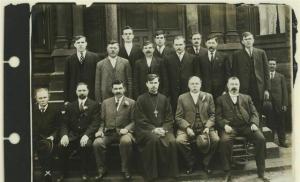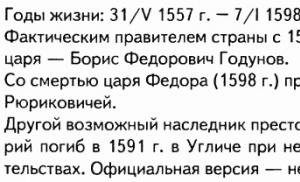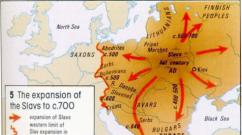Open Library - an open library of educational information. Waves of Russian emigration The first wave of emigrants
B XX century Dramatic and very serious changes were taking place in our country, to which not all Russians were able to adapt. For decades, many Russians lived in difficult material and living conditions. Not everyone was satisfied with the authorities’ promises of a good life that was about to come. “Fish seeks where it is deeper, and man seeks where it is better,” this is how people formulated the reason for the “wanderlust” that many residents of the country discovered.
Emigration (from Latin emigro - moving out) is the departure of citizens from their country to another country for permanent residence (or for a more or less long period) for political, economic and other reasons.
It is customary to talk about four waves of emigration: after the 1917 revolution and the Civil War; during and after the Great Patriotic War and the Second World War; in the late 60s - 70s. XX century; in the last decade of the 20th century. and the first decade of the 21st century.
But you need to know that the first and fairly large emigration flow took place in pre-revolutionary Russia.
B 1906-1910 950,284 Russian residents left Russia for the United States. In terms of the number of people resettled, Russia ranked third among other countries after Italy and Austria-Hungary. Among those leaving for America, the majority were Jews (44.1%), Poles (27.2%), Lithuanians, Finns, Germans, and only 4.7% of those leaving were Russians.
Many Russians left the country after 1917, during and as a result of the Civil War. The most commonly cited figure is 2 million emigrants from this “wave.” It was named by the famous writer I. A. Bunin in his lecture on the spiritual mission of the Russian emigration. According to documentary data from the Russian Foreign Archive in Prague, the total number of people who left Russia in those years did not exceed 700 thousand people, including those who emigrated to China. After World War II, out of the millions of people driven away from the USSR, there were 120-140 thousand people in camps for displaced persons, where Soviet citizens who did not want to return to their homeland were kept.
Russian diasporas formed in Western European (Germany, France), Slavic (Yugoslavia, Bulgaria, Czechoslovakia), border (Poland, Finland, Romania, Baltic states) countries, and also appeared in the USA, Canada and Australia, in Latin America, in China.
Russian emigrants had to adapt to life in countries that differed in their economic situation, religious characteristics, political regimes, and cultural traditions. The official policy pursued towards national minorities in general and Russian refugees in particular was also different.
By the mid-20s. XX century More than 500 thousand Russian emigrants lived in Germany, 400-450 thousand in France, about 100 thousand in Poland, more than 30 thousand in Yugoslavia, 30-35 thousand in Bulgaria, more than 22 thousand in Czechoslovakia In the Far East, in the exclusion zone of the Chinese Eastern Railway there were up to 400 thousand Russians, 200 thousand of whom lived in Harbin.
In the first years after leaving Russia, many emigrants thought that the Bolsheviks would not last long and that they would be able to return to their homeland. Emigrant organizations operated abroad, trying to undermine Soviet power from within or organize a new intervention. Some repented and returned home before the end of the 20s. The transformation of the CCCP into a powerful power, the victory in the Great Patriotic War of 1941-1945, and the preservation of a strict political regime in the post-war CCCP accelerated the process of sociocultural adaptation of Russian emigrants. Their children and grandchildren already felt not so much Russian as Americans, Canadians, Germans, French, etc. After the Communist victory over the Chiang Kai-shekists in China, new emigration of Russians to Australia, North America or Japan followed.
The Russian emigration did not represent a single whole. But adherence to Orthodoxy, the Russian language and Russian culture played an important role in maintaining a spiritual connection with Russia. Many people abroad became acquainted with Russia through emigrants. Emigration has become a unique historical phenomenon. It connected old and new Russia, Russia and Europe, and other regions. Many Russian emigrants were true patriots of Russia and tried to be useful to it.
You can download ready-made answers for the exam, cheat sheets and other educational materials in Word format at
Use the search form
The first wave of Russian emigration: centers, ideology, political activity, leaders
relevant scientific sources:
- Investments, finance, risks. Lectures
| Lecture(s) | | Russia | docx | 3.57 MB
Development of an investment project 1. General provisions Schedule 1. Classification of investments 2. Sources of raising capital 2.1. Investments from own funds 2.2. Credits 2.3. Creation
- From the works of A. A. Shakhmatov on the modern Russian language (the doctrine of parts of speech)
State educational and pedagogical publishing house of the Ministry of Education of the RSFSR Moscow. 1952 | Scientific book | 1952 | docx/pdf | 11.55 MB
Soviet linguistics, armed with Marxist-Leninist methodology and directed by I.V. Stalin onto the broad road of free scientific development, must use for its generalizations,
- Tsar-derivatives in Russian discourse: a comprehensive description
Gonnova Natalya Viktorovna | Dissertation for the academic degree of Candidate of Philological Sciences. Samara - 2017 | Dissertation | 2017 | Russia | docx/pdf | 2.63 MB
- Historical grammar of the Russian language
Ivanov V.V. | Textbook for pedagogical students. Institute for specialties „Rus. language and lit.“ - 3rd ed., revised. and additional - M.: Education, 1990 - 400 pp.: ill. | Tutorial | 1990 | pdf | 12.89 MB
The textbook, which is the main guide to the historical grammar of the Russian language, provides information on all the main topics of the program. In the third edition, the author significantly revised almost everything
- Grammatical variants in the Russian language: cognitive-evolutionary aspect
Popov Sergey Leonidovich | Dissertation for the degree of Doctor of Philology. Kharkov - 2015 | Dissertation | 2015 | Ukraine | docx/pdf | 3.15 MB
Specialty 10.02.02 - Russian language. The variation observed in the Russian grammatical structure has been of interest to both linguists and ordinary native speakers for centuries. Still relevant
- Russian phraseological units with the components “head”, “hand”, “heart” against the background of the Chinese language
Wu Shu-Hua | Dissertation for the degree of candidate of philological sciences. St. Petersburg - 2007 | Dissertation | 2007 | Russia | docx/pdf | 5.17 MB
Specialty 10.02.01 - Russian language. Each language system has its own distinct specifics, which reflects different aspects of culture, spheres of life, history, knowledge and mentality of the people - the creator and
The first wave of Russian emigration: centers, ideology, political activity, leaders...
1. General characteristics of the first wave of Russian emigration
1.1 Development of the first wave of emigration in Russia.
Let's start, naturally, with the First emigrant wave. It is also called the White Emigration, and it is clear why. After the defeats of the White Army in the North-West, units of General Yudenich’s army became the first military emigrants, interned in Estonia in 1918. Of the most cultural;
After the defeats in the East, another center of the emigration diaspora (approximately 400 thousand people) formed in Manchuria with its center in Harbin.
After the defeats in the South, steamships departing from the Black Sea ports in the rear of the retreating Denikin and Wrangel troops (mainly Novorossiysk, Sevastopol and Odessa), as a rule, headed for Constantinople, which for a time became “Little Russia”. Save your profession
Introduction
Russian emigration of the first post-revolutionary wave, often referred to as “White,” is a unique phenomenon unprecedented in world history. And not only by its scale, but also by its contribution to world and Russian culture. Many traditions;
The first wave of emigrants not only preserved, but also enhanced many traditions of Russian culture. Many brilliant pages in the history of world literature, science, ballet, theater, cinema, painting, etc. were written by them. It was they who created the “mainland”, not outlined on any map of the world, with the name “Russian Abroad”. Many traditions;
Geographically, this emigration from Russia was primarily directed to the countries of Western Europe. Paris, Berlin, Prague, Belgrade, Sofia became the main centers of Russian emigration of the first wave. Also, a significant part of the emigrants settled in Harbin, and at first in Constantinople. Many traditions;
Back in the 19th century, the first Russian labor and religious emigrants appeared in Australia, but this was not a mass phenomenon. It should be noted that N.N. Miklouho-Maclay planned to organize a Russian colony in New Guinea, and his idea was favorably received by Alexander III, but nothing came of it. After 1905, the first political emigrants began to appear in Australia. After 1917-1921 New emigrants appeared in Australia, fleeing Soviet Russia, but there were extremely few of them. Brisbane, Melbourne, Sydney were significant centers of new emigration.
Fragment of work for review
In a similar way, such prominent politicians as Dan, Kuskova, Prokopovich, Peshekhonov, and Ladyzhensky were expelled from the USSR. Apparently, the Decree of the All-Russian Central Executive Committee “On Administrative Expulsion” of August 10, 1922 was applied to both of them. The League of Nations achieved the designated successes in providing assistance to Russian emigrants. F. Nansen, the famous Norwegian polar explorer, appointed Commissioner for Russian Refugees in February 1921, introduced unusual identity cards for them (the so-called “Nansen passports”), which were eventually recognized in 31 countries around the world. It took place in the fall; Approximately 25 thousand refugees were employed (mainly in the USA, Austria, Belgium, Germany, Hungary and Czechoslovakia) with the help of the organization founded by Nansen (Refugees Settlement Commission). It took place in the fall; On November 1, 1920, the total number of emigrants from Russia, according to estimates by the American Red Cross, was 1,194 thousand people; this estimate was later raised to 2,092 thousand people. It took place in the fall; A. and E. Kulisher, this most authoritative estimate of the number of “white emigration” also speaks of 1.5-2.0 million people. It was based, among other things, on selective data from the League of Nations, which recorded, as of August 1921, more than 1.4 million refugees from Russia. At the same time, the total number of people who emigrated from Russia in 1918-1924 is estimated at at least 5 million people by V. Kabuzan, including about 2 million optants, that is, residents of the former Russian (Polish and Baltic) provinces included in the newly formed independent states. An extremely difficult, but still important task is to separate emigration from option: in 1918-1922, the total number of emigrants and repatriates was (for a number of countries, selectively): to Poland - 4.3 million. people, to Latvia - 120 thousand people, to Lithuania - 205 thousand people. Maintain a profession; Many, especially in Poland, were in fact transit emigrants and did not stay there for long. It took place in the fall; 854 thousand people, in 1930 it decreased to 624 thousand and in 1937 to 447 thousand people. In 1922, according to N.A. Struve, summary number of Russian emigration. Many, especially; Save the profession; 1.2 The first wave of Russian emigration: centers, ideology, political activity, leaders Emigration of the first wave (Russian White Emigration) is a wave of emigration from Russia, which arose as a result of the events of the almost six-year Civil War (1917-1923). Many, especially; This emigration geographically from Russia was primarily directed to the countries of Western Europe. Paris, Berlin, Prague, Belgrade, Sofia became the main centers of Russian emigration of the first wave. Preserve the profession; Also, a significant part of the emigrants settled in Harbin, and at first in Constantinople. Many, especially; In Australia, the first Russian labor and religious emigrants appeared in the 19th century, but this was not a mass phenomenon. Save the profession; After 1905, the first political emigrants began to appear in Australia. Save your profession; After 1917-1921 New emigrants appeared in Australia who escaped from Soviet Russia, but there were very few of them. The most important centers of new emigration were Brisbane, Melbourne, and Sydney. Many, especially the emigrants of that time, thought their expulsion was a forced and short-lived episode, hoping for a quick return to Russia, after what seemed to them a quick collapse of the Soviet state. In many ways, these reasons; In many ways, these reasons are caused by their desire to isolate themselves from active participation in the life of their host countries, opposition to assimilation and reluctance to adapt to a new life. Largely for these reasons; They tried to limit their lives to the confines of the emigrant colony. The first emigration consisted of the most cultural strata of Russian pre-revolutionary society, with a disproportionately large share of the military. According to the League of Nations, a total of 1 million 159 thousand refugees left Russia after the revolution. About a quarter of them belonged to the White armies, having emigrated at different times from various fronts. Largely for these reasons; The number of the Russian colony in Manchuria before the revolution was no less than 220-235 thousand people, and by November 1920 - no less than 297 thousand people. With the abolition of the extraterritoriality status for Russian citizens in China on September 23, 1920, the entire Russian population in China, including refugees, was transferred to the unenviable position of stateless emigrants in a foreign state, that is, to the position of a de facto diaspora. Largely for these reasons; the first serious flow of Russian refugees in the Far East dates back to the beginning of 1920. The second - in October-November 1920, when the army of the so-called “Russian Eastern Outskirts” under the command of Ataman G.M. was defeated. Semenov. Largely due to these reasons; Third - at the end of 1922, when Soviet power was irrevocably established in the region, only a few thousand people left by sea, the main flow of refugees rushed from Primorye to Manchuria and Korea, to China, with some exceptions, they were not released, some were even sent to Soviet Russia. At the same time, in China, and actually in Xinjiang in the north-west of the country, there was another significant (more than 5.7 thousand people) Russian colony, which consisted of the Cossacks of General Bakich and former officials of the White Army, who retreated here after the defeats in the Urals and in Semirechye, they settled in the countryside and were engaged in agricultural work. Largely for these reasons; In 1923, the total population of the Russian colonies in Manchuria and China, when the war had already ended, was estimated at approximately 420 thousand people. Of this number, at least 115 thousand acquired Soviet passports in 1922-1923, many of them - at least 120 thousand people - repatriated to the RSFSR (the amnesty announced on November 3, 1921 for ordinary members of the White Guard formations also played a role here). Largely due to these reasons; Significant (sometimes up to tens of thousands of people per year) were during the 1920s the re-emigration of Russians to other countries, especially young people drawn to universities (in particular, to the USA, Australia and South America, as well as Europe ).At the beginning of 1920 there was also the first flow of refugees in the south of Russia. General Wrangel formed the so-called “Emigration Council” back in May 1920; a year later, it was renamed the Council for the Resettlement of Russian Refugees. Civilian and military refugees were resettled in camps near Constantinople, on the Princes' Islands. In Bulgaria, in Gallipoli, Chataldzha and Lemnos (Kuban camp), military camps were under English or French administration. According to the Evacuation of Wrangel's Army, the last operations took place from November 11 to 14, 1920. 17 thousand Cossacks were loaded onto ships, 13 thousand officers and 4-5 thousand soldiers of regular units, 10 thousand cadets, 7 thousand wounded officers, more than 30 thousand officers and rear officials and up to 60 thousand civilians, mainly family members of officers and officials. Largely for these reasons; It was this Crimean wave of evacuees that emigration was especially difficult. Largely for these reasons; At the end of 1920, the card index of the Main Information (or Registration) Bureau already numbered 190 thousand names with addresses. At the same time, the number of military personnel was estimated at 50-60 thousand people, and civilian refugees - at 130-150 thousand people. By the end of the winter of 1921, only the poorest and indigent, as well as the military, remained in Constantinople. Largely for these reasons; Spontaneous re-evacuation began, especially of peasants and captured Red Army soldiers who did not fear reprisals. By February 1921, the number of such re-emigrants reached 5 thousand people. 6.7 thousand Cossacks were added to them in March. Over time, it also took on organized forms. Largely for these reasons; General Wrangel turned to the Bulgarian and Yugoslav governments in the spring of 1921 with a request about the possibility of settling the Russian army on their territory. Consent was received in August. At the expense of the state, the Cavalry Division of Barbovich, the Kuban and a share of the Don Cossacks (with weapons; their duties included border service and government work) were accepted by Yugoslavia (the Kingdom of Serbs, Croats and Slovenes). And Bulgaria - the entire 1st Corps, military schools and a share of the Don Cossacks (without weapons). At the same time, approximately 20% of the army personnel left the army and became refugees. A spontaneous outbreak began; About 35 thousand Russian emigrants (mostly military) were settled in various, mainly Balkan countries: 22 thousand ended up in Serbia, 6 thousand in Tunisia (port of Bizerte), 5 thousand in Bulgaria and 3 thousand each in Romania and Greece . Largely for these reasons; the League of Nations achieved established success in helping Russian emigrants. F. Nansen, the famous Norwegian polar explorer, appointed Commissioner for Russian Refugees in February 1921, introduced special identity cards for them (the so-called “Nansen passports”), which were eventually recognized in 31 countries around the world. Largely for these reasons; With the help of the organization founded by Nansen (Refugees Settlement Commission), approximately 25 thousand refugees were employed (mainly in the USA, Austria, Belgium, Germany, Hungary and Czechoslovakia). Largely for these reasons; Separating emigration from option is a very difficult, but still important task: in 1918-1922, the total number of emigrants and repatriates was (for a number of countries, selectively): to Poland - 4.1 million people, to Latvia - 130 thousand people, to Lithuania - 215 thousand people. Maintain a profession; Many, especially in Poland, were in fact transit emigrants and did not stay there for long. Largely for these reasons; In 1922, according to N.A. Struve, the total number of Russian emigration was 863 thousand people; in 1930 it decreased to 630 thousand and in 1937 to 450 thousand people. Largely for these reasons; According to incomplete data from the League of Nations Refugee Service, in 1926, 755.3 thousand Russian and 205.7 thousand Armenian refugees were officially registered. Largely for these reasons; More than half of the Russians - approximately 400 thousand people - were then accepted by France; in China there were 76 thousand of them, in Yugoslavia, Latvia, Czechoslovakia and Bulgaria there were approximately 30-40 thousand people each (in 1926, in total there were approximately 220 thousand immigrants from Russia in Bulgaria). Most Armenians found refuge in Syria, Greece and Bulgaria (approximately 124, 42 and 20 thousand people, respectively). Largely for these reasons; Constantinople, which served as the main transshipment base for emigration, lost its importance over time. Largely for these reasons; Berlin and Harbin (before its occupation by the Japanese in 1936), as well as Belgrade and Sofia, became recognized centers of the “first emigration” (also called White). The Russian population of Berlin numbered approximately 200 thousand people in 1921; it suffered especially during the years of the economic crisis, and by 1925 there were only 30 thousand people left. Largely for these reasons; Later, Prague and Paris moved into first place. The rise to power of the Nazis further alienated Russian emigrants from Germany. Prague and, in particular, Paris took the first places in emigration. Preserve the profession; Even on the eve of the Second World War, but especially during the hostilities and soon after the war, a tendency emerged for part of the first emigration to move to the United States. Relatively few, mainly representatives of the intelligentsia, both artistic and and scientific. Maintain your profession; 1.3 Features of Russian emigration In the history of Russia, internal colonization has always played a significant role, and mass emigration took second place. However, it cannot be said that Russia was completely ignorant of emigration. Preserve the profession; Russia participated in the great intercontinental migrations of the end of the last - beginning of this century. From 1861 to 1915, 4.5 million people left the Russian Empire, including almost 2.5 million in the first 16 years of the 20th century. Two-thirds of emigrants headed to the United States, and of those who left in the twentieth century - approximately 80%. True, a significant part of the emigrants left not from present-day Russia, but from other parts of the former empire - Belarus, Ukraine, and the Baltic states. Emigration from the USSR also existed. It broke up into three main streams, usually called the “first”, “second” and “third” emigration. These flows were determined mainly by political reasons. The “first” and “second” flows are mainly forced “waves” of emigration during the First World War, the Civil War and the Second World War, the “third” flow is voluntary, mainly “ethnic” emigration during the Cold War. This division is quite arbitrary, because Emigration flows almost never depleted, sometimes weakening, sometimes increasing. Now, due to the availability of many previously closed archival funds and their publications, previously prohibited, and the absence of political censorship, the prerequisites are being formed for displaying much previously hidden historical truth and eliminating distortions in public historical consciousness. It is also worth noting that some current publications express a tendency to move from unbridled criticism of emigration to its unbridled exaltation. In the early 20s of the twentieth century, the process of formation and political self-determination of emigrant organizations took place, and extensive coalition alliances emerged. The Supreme Monarchical Council was one of these unions, which was formed during the Reichengall Congress in Bavaria in 1921 on the initiative of N. Markov. This organization had its representatives in many countries of the world. Soon, in contrast to the monarchists, in 1921 - 1924, the Republican-Democratic Association of Russian Emigrants was founded, uniting in its ranks a wide political spectrum of Russian liberal democrats from the Cadets to the right Socialist Revolutionaries and Popular Socialists, led by P. N. Milyukov. Modifications in the internal policies of the Soviet government became the main factor stimulating the political activity of emigration. The transition to the NEP also generated considerable hopes and expectations among Russian emigrants. A number of factors determined the very process of political formation of Russian emigration. During the Civil War, all opponents of the Bolshevik government relied on the entire officer-general corps of the former tsarist army. While the whites had a chance to win, political movements and parties opposed to the soviets united with the entire movement, helping it morally and materially. But attempts to overthrow the Soviet regime by armed means failed, which forced them to look for new means and methods of struggle. At the same time, the number of emigrants increased, which intensified the founding and unification of their political organizations. The representative of the “other”, alternative Russia was the Russian emigration. This was a society of Russians united by different political ideals, spiritual values, and cultural traditions than the ideological and moral foundations that emerged during the revolution and Civil War in Soviet Russia. In Soviet Russia, the activities of international emigration were closely monitored. V.I. Lenin, speaking at the Third Congress of the Comintern, said: “Now, after we have repelled the attacks of the international counter-revolution, a foreign organization of the Russian bourgeoisie and all Russian counter-revolutionary parties has been formed... In almost every country they publish daily newspapers... ... have countless connections with foreign bourgeois elements, that is, they acquire enough money to have their own press; we can monitor abroad the general work of all our former political parties without exception. .. These people are making every possible attempt, they cleverly take advantage of any opportunity to attack Soviet Russia in one form or another and divide it. It would be very instructive... to systematically follow the most important aspirations, the most important tactics, the most important currents of this Russian counter-revolution... These counter-revolutionary emigrants are very knowledgeable, superbly organized and good strategists...” The political attitude of the country’s leadership was perceived with perfectly understood by the Soviet intelligence services.In a documented letter from the GPU dated March 20, 1922, local authorities were ordered to intensify their work on monitoring counter-revolutionary organizations both within the country and abroad.
Bibliography
Bibliography
1. Antropov, O.K. History of domestic emigration: Textbook. Book 3: The second wave of domestic emigration and its culture / O.K. Antropov. -Astrakhan, 2003. 83 p.
2. A. Akhiezer. Past and present emigration from Russia // Migration situation in Russia: socio-political aspects. M., 1994, Migration Research Program. Vol. IV. p.44-45
3. Zh.A. Zayonchkovskaya. Emigration to foreign countries // Demoscope Weekly No. 27-28, July 30 – August 12, 2001
4. Skutnev A.V. Protest movement in the USSR in 1945 – 1985: emigration and dissident movement. - Kirov, 2011. – 105 p.*
5. Kisileva A.F., Shchagina E.M.//Modern history of the Fatherland XX century, textbook for universities in 2 volumes, volume I//M.: Humanit. ed. VLADOS center, 1998, p. 9
6. Pushkareva N.L. The emergence and formation of the Russian diaspora abroad // "Domestic History". - 1996. - 1 - P. 53-65
7. Journal = //Editorial board: Mironov A.V., Andreev E.M. “Social and humanitarian knowledge” //M. 2003, No. 4 p. 20
8. . Emigration: who and when left Russia in the 20th century // Pavel Polyan; Russia and its regions in the 20th century: territory - settlement - migration / Ed. O. Glezer and P. Polyana. - M: OGI, 2005. - P. 493-519.
Please carefully study the content and fragments of the work. Money for purchased finished works will not be returned due to the fact that the work does not meet your requirements or is unique.
* The category of work is of an evaluative nature in accordance with the qualitative and quantitative parameters of the material provided. This material, neither in its entirety nor any of its parts, is a finished scientific work, final qualifying work, scientific report or other work provided for by the state system of scientific certification or necessary for passing intermediate or final certification. This material is a subjective result of processing, structuring and formatting the information collected by its author and is intended, first of all, to be used as a source for independent preparation of work on this topic.
In the book: People and destinies of Russian Abroad. Vol. 3. M.: Institute of General History of the Russian Academy of Sciences, 2016. P. 204-228.
The article is devoted to the tragic fate of a prominent political figure, Trudovik, a man of encyclopedic knowledge V.V. Vodovozov and his wife O.A. Vodovozova-Vvedenskaya, who were unable to adapt in exile and committed suicide. The article was written on the basis of documents that were not previously used by researchers (GA RF F. 5962. V.V. Vodovozov). Documents of the V.V. Foundation Vodovozov, first introduced into scientific circulation, allow one to judge the environment of the Vodovozovs in the last years of their lives, and the relationships between Russian scientists in emigration.
The article examines the features of the genre of writing to a newspaper in exile and in the USSR. This topic seems interesting because it is closely related to the cultural characteristics of emigration and the metropolis. When considering letters to emigrant and Soviet newspapers, we are dealing with different communicative situations, depending on different cultural and political factors.
The article shows to what extent the implementation of the same illocutionary intention (in this case, gratitude) and the very content of the letter are influenced by the sociocultural context, different levels of literary language proficiency among the authors of the letters, their different social status, etc.
N. Novgorod: Papyrus, 2011.
The collective monograph includes the main results of interdisciplinary research in the field of violence and abuse of children.
Nikishina E. A. In bk.: Multilingualism. Proceedings of the 23rd Scandinavian Conference of Linguistics. Iss. 8. Uppsala: Uppsala Universitet Acta Universitatis Upsaliensis, 2009. P. 258-271.
The article examines the language situation in Moscow schools with an ethnocultural (national) component, which are a new form of national schools. The research material was interviews recorded in 2007 in two Moscow schools: with an Armenian ethnocultural and an Azerbaijani ethnocultural component. The sample included 10 people from each school (5 boys and 5 girls), i.e. 20 respondents in total.
The article describes in detail the process of linguistic integration of Armenian and Azerbaijani children into modern Russian society. The comparison of these two groups is especially interesting because Soviet Russification occurred differently in Armenia and Azerbaijan, and the language situations are generally different in the two countries. The article shows how these differences affect the language use of Armenian and Azerbaijani children.
The prototype of historiography appears in the Middle East (in Sumer, Akkad and Egypt) along with the advent of writing, in the 3rd - 2nd millennium BC. e. Lists of rulers, historical inscriptions of kings, ancient weather and other records of major events, as well as chronicles can be considered the first historical texts. In this case, a targeted selection and interpretation of historical facts arises (for example, in the inscriptions of the Ancient, Middle and especially New Kingdoms in Egypt, glorifying the deeds and aggressive campaigns of the pharaohs). It is extremely important to note the emergence of state, temple and private archives. Gradually, there is a complication and change in the forms of historical writings, in which the first - still very undeveloped - ideas about the causes of historical events that were explained by the “will of the gods” appear.
Vasily Alekseevich Maklakov and Vasily Vitalievich Shulgin belonged to the political elite of Russia at the beginning of the 20th century. Both were deputies of the 2nd-4th State Dumas and prolific publicists. Maklakov was a member of the Cadet Party, a liberal, Shulgin was a right-winger, a nationalist and a monarchist. The difference in political views did not prevent them from being friends. After the revolution, both ended up in exile. Their correspondence for 1919-1939 contains unique information about the political life of Russia at the beginning of the 20th century, the Russian revolutions and the Civil War, and the history of emigration. The correspondence is a source on the history of Russian political thought and at the same time a literary monument, a brilliant example of the epistolary genre. The letters, published without any exceptions or abbreviations, are stored primarily in the archives of the Hoover Institution at Stanford University (USA); part of the correspondence is in the State Archives of the Russian Federation and the manuscript department of the British Library.
Let's start, naturally, with the First emigrant wave. It is also called the White emigration, and it is clear why. After the defeats of the White Army in the North-West, the first military emigrants were units of General Yudenich’s army, interned in 1918 in Estonia. After the defeats in the East, another center of the emigration diaspora (approximately 400 thousand people) formed in Manchuria with its center in Harbin. After the defeats in the South, steamships departing from the Black Sea ports in the rear of the retreating Denikin and Wrangel troops (mainly Novorossiysk, Sevastopol and Odessa), as a rule, headed for Constantinople, which for a time became “Little Russia”.
Before the revolution, the number of the Russian colony in Manchuria was no less than 200-220 thousand people, and by November 1920 it was no less than 288 thousand people. With the abolition of the extraterritoriality status for Russian citizens in China on September 23, 1920, the entire Russian population there, including refugees, moved to the unenviable position of stateless emigrants in a foreign state, that is, to the position of a de facto diaspora. Throughout the entire turbulent period of the Civil War in the Far East (1918-1922), there was a significant mechanical movement of the population, which consisted, however, not only in the influx of population, but also in its significant outflow - due to Kolchak, Semenov and other mobilizations, re-emigration and repatriation to Bolshevik Russia.
The first serious flow of Russian refugees in the Far East dates back to the beginning of 1920 - the time when the Omsk Directory had already fallen; the second - in October-November 1920, when the army of the so-called “Russian Eastern Outskirts” under the command of Ataman G.M. was defeated. Semenov (his regular troops alone numbered more than 20 thousand people; they were disarmed and interned in the so-called “Qiqihar camps”, after which they were resettled by the Chinese to the Grodekovo region in the south of Primorye); finally, the third, at the end of 1922, when Soviet power was finally established in the region (only a few thousand people left by sea, the main flow of refugees was sent from Primorye to Manchuria and Korea, to China, to the CER, with some exceptions, they were not allowed through; some they were even deported to Soviet Russia).
It should be pointed out that, along with the “white” emigration, in China, in particular in 1918-1922 in Shanghai, there was also a “red” emigration for some time, although not numerous (about 1 thousand people). After the end of the civil war in Primorye, most of the revolutionaries returned to the Far East. In November 1922, as if to “replace” them, 4.5 thousand white emigrants arrived on the ships of the squadrons of rear admirals Stark and Bezoir; in September 1923, they were joined by the remnants of the Far Eastern flotilla with refugees on board. The situation of the emigrant colony in Shanghai, compared to Europe and Harbin, was incomparably more difficult, including due to the impossibility of competition with the Chinese in the field of unskilled labor. The second largest, but perhaps the first most enterprising Russian emigrant colony in inland China was the community in Tianjin. In the 1920s, about two thousand Russians lived here, and in the 1930s there were already about 6 thousand Russians. Several hundred Russian emigrants each settled in Beijing and Hangzhou.
At the same time, in China, namely in Xinjiang in the north-west of the country, there was another significant (more than 5.5 thousand people) Russian colony, consisting of the Cossacks of General Bakich and former officials of the White Army, who retreated here after defeats in the Urals and in Semirechye: they settled in rural areas and were engaged in agricultural work.
The most prominent “refugees” (aristocrats, officials and merchants) were usually able to pay for tickets, visas and other fees. Within one or two weeks in Constantinople, they settled all the formalities and went further to Europe, mainly to France and Germany: by the beginning of November 1920, according to Red Army intelligence, their number reached 35-40 thousand people.
Such a statistically insignificant, but politically “loud” emigration action of Soviet Russia as the deportation of humanities scientists in 1922 is also worthy of mention. It took place in the autumn of 1922: two famous “philosophical ships” transported about 50 outstanding Russian humanists (together with their family members - approximately 115 people) from Petrograd to Germany (Stettin). In a similar way, such prominent politicians as Dan, Kuskova, Prokopovich, Peshekhonov, and Ladyzhensky were expelled from the USSR. Apparently, the Decree of the All-Russian Central Executive Committee “On Administrative Expulsion” of August 10, 1922 was applied to both of them.
The League of Nations achieved some success in helping Russian emigrants. F. Nansen, the famous Norwegian polar explorer, appointed Commissioner for Russian Refugees in February 1921, introduced special identity cards for them (the so-called “Nansen passports”), which were eventually recognized in 31 countries around the world. With the help of the organization created by Nansen (Refugees Settlement Commission), about 25 thousand refugees were employed (mainly in the USA, Austria, Belgium, Germany, Hungary and Czechoslovakia).
The total number of emigrants from Russia, on November 1, 1920, according to estimates of the American Red Cross, was 1,194 thousand people; this estimate was later increased to 2,092 thousand people. The most authoritative estimate of the number of “white emigration”, given by A. and E. Kulischer, also speaks of 1.5-2.0 million people. It was based, among other things, on selective data from the League of Nations, which recorded, as of August 1921, more than 1.4 million refugees from Russia. This number also included 100 thousand German colonists, 65 thousand Latvians, 55 thousand Greeks and 12 thousand Karelians. By country of arrival, emigrants were distributed as follows (thousands of people): Poland - 650, Germany - 300, France - 250, Romania - 100, Yugoslavia - 50, Greece - 31, Bulgaria - 30, Finland - 19, Turkey - 11 and Egypt - 3.
At the same time, V. Kabuzan estimates the total number of those who emigrated from Russia in 1918-1924 to be at least 5 million people, including about 2 million optants, that is, residents of the former Russian (Polish and Baltic) provinces that were included in newly formed sovereign states.
In 1922, according to N.A. Struve, the total number of Russian emigration was 863 thousand people; in 1930 it decreased to 630 thousand and in 1937 to 450 thousand people. The territorial distribution of Russian emigration is presented in table. 1.
Emigration of the first wave (Russian White Emigration) is a wave of emigration from Russia that arose as a result of the events of the almost six-year Civil War (1917-1923). Geographically, this emigration from Russia was primarily directed to the countries of Western Europe. The main centers of Russian emigration of the first wave were Paris, Berlin, Prague, Belgrade, and Sofia. A significant part of the emigrants also settled in Harbin, and at first in Constantinople. The first Russian labor and religious emigrants to Australia appeared in the 19th century, but this was not a mass phenomenon. After 1905, the first political emigrants began to appear in Australia. After 1917-1921 New emigrants appeared in Australia, fleeing Soviet Russia, but there were very few of them. The main centers of new emigration were Brisbane, Melbourne, and Sydney.
The emigrants of that time considered their exile to be a forced and short-term episode, hoping for a quick return to Russia after what they thought was a quick collapse of the Soviet state. In many ways, these reasons are due to their desire to isolate themselves from active participation in the life of their host countries, opposition to assimilation and reluctance to adapt to a new life. They sought to limit their life to the emigrant colony.
The first emigration consisted of the most cultured strata of Russian pre-revolutionary society, with a disproportionately large share of military personnel. According to the League of Nations, a total of 1 million 160 thousand refugees left Russia after the revolution. About a quarter of them belonged to the White armies, which emigrated at different times from different fronts.
Before the revolution, the number of the Russian colony in Manchuria was no less than 200-220 thousand people, and by November 1920 it was no less than 288 thousand people. With the abolition of the extraterritoriality status for Russian citizens in China on September 23, 1920, the entire Russian population there, including refugees, moved to the unenviable position of stateless emigrants in a foreign state, that is, to the position of a de facto diaspora.
The first serious flow of Russian refugees in the Far East dates back to the beginning of 1920 - time. The second - in October-November 1920, when the army of the so-called “Russian Eastern Outskirts” under the command of Ataman G.M. was defeated. Semenov. The third - at the end of 1922, when Soviet power was finally established in the region (only a few thousand people left by sea, the main flow of refugees was sent from Primorye to Manchuria and Korea, to China, with some exceptions, they were not allowed in, some were even expelled to Soviet Russia.
At the same time, in China, namely in Xinjiang in the north-west of the country, there was another significant (more than 5.5 thousand people) Russian colony, consisting of the Cossacks of General Bakich and former officials of the White Army, who retreated here after defeats in the Urals and in Semirechye, they settled in rural areas and were engaged in agricultural work.
The total population of the Russian colonies in Manchuria and China in 1923, when the war had already ended, was estimated at approximately 400 thousand people. Of this number, at least 100 thousand received Soviet passports in 1922-1923, many of them - at least 100 thousand people - repatriated to the RSFSR (the amnesty announced on November 3, 1921 for ordinary members of the White Guard formations also played a role here). Throughout the 1920s, the re-emigration of Russians to other countries was also significant (sometimes up to tens of thousands of people per year), especially young people seeking to attend universities (in particular, to the USA, Australia and South America, as well as Europe).
The first flow of refugees in the south of Russia also took place at the beginning of 1920. Back in May 1920, General Wrangel established the so-called “Emigration Council,” which a year later was renamed the Council for the Resettlement of Russian Refugees. Civilian and military refugees were resettled in camps near Constantinople, on the Princes' Islands and in Bulgaria; military camps in Gallipoli, Chatalja and Lemnos (Kuban camp) were under English or French administration. The last evacuation operations of Wrangel's army took place from November 11 to 14, 1920: 15 thousand Cossacks, 12 thousand officers and 4-5 thousand soldiers of regular units, 10 thousand cadets, 7 thousand wounded officers, more than 30 thousand officers and officials were loaded onto the ships rear and up to 60 thousand civilians, mainly family members of officers and officials. It was this Crimean wave of evacuees that found emigration particularly difficult.
At the end of 1920, the card index of the Main Information (or Registration) Bureau already included 190 thousand names with addresses. At the same time, the number of military personnel was estimated at 50-60 thousand people, and civilian refugees at 130-150 thousand people.
By the end of the winter of 1921, only the poorest and most destitute, as well as the military, remained in Constantinople. A spontaneous re-evacuation began, especially of peasants and captured Red Army soldiers who did not fear reprisals. By February 1921, the number of such re-emigrants reached 5 thousand people. In March, another 6.5 thousand Cossacks were added to them. Over time, it also took on organized forms.
In the spring of 1921, General Wrangel turned to the Bulgarian and Yugoslav governments with a request for the possibility of settling the Russian army on their territory. In August, consent was received: Yugoslavia (the Kingdom of Serbs, Croats and Slovenes) accepted at the state expense the Barbovich Cavalry Division, the Kuban and part of the Don Cossacks (with weapons; their duties included border service and government work), and Bulgaria - the entire 1- th Corps, military schools and part of the Don Cossacks (without weapons). About 20% of the army personnel left the army and became refugees.
About 35 thousand Russian emigrants (mostly military) were settled in various, mainly Balkan countries: 22 thousand ended up in Serbia, 5 thousand in Tunisia (port of Bizerte), 4 thousand in Bulgaria and 2 thousand each in Romania and Greece.
The League of Nations achieved some success in helping Russian emigrants. F. Nansen, the famous Norwegian polar explorer, appointed Commissioner for Russian Refugees in February 1921, introduced special identity cards for them (the so-called “Nansen passports”), which were eventually recognized in 31 countries around the world. With the help of the organization created by Nansen (Refugees Settlement Commission), about 25 thousand refugees were employed (mainly in the USA, Austria, Belgium, Germany, Hungary and Czechoslovakia).
The total number of emigrants from Russia, on November 1, 1920, according to estimates of the American Red Cross, was 1,194 thousand people; this estimate was later increased to 2,092 thousand people. The most authoritative estimate of the number of “white emigration”, given by A. and E. Kulischer, also speaks of 1.5-2.0 million people. It was based, among other things, on selective data from the League of Nations, which recorded, as of August 1921, more than 1.4 million refugees from Russia. This number also included 100 thousand German colonists, 65 thousand Latvians, 55 thousand Greeks and 12 thousand Karelians. According to the countries of arrival, emigrants were distributed as follows (thousands of people): Poland - 650; Germany - 300; France - 250; Romania - 100; Yugoslavia - 50; Greece - 31; Bulgaria - 30; Finland - 19; Türkiye - 11 and Egypt - 3.
Separating emigration from option is a very difficult, but still important task: in 1918-1922, the total number of emigrants and repatriates was (for a number of countries, selectively): to Poland - 4.1 million people, to Latvia - 130 thousand people, to Lithuania - 215 thousand people. Many, especially in Poland, were actually transit emigrants and did not stay there for long.
In 1922, according to N.A. Struve, the total number of Russian emigration was 863 thousand people; in 1930 it decreased to 630 thousand and in 1937 to 450 thousand people.
According to incomplete data from the League of Nations Refugee Service, in 1926, 755.3 thousand Russian and 205.7 thousand Armenian refugees were officially registered. More than half of the Russians - about 400 thousand people - were then accepted by France; in China there were 76 thousand of them, in Yugoslavia, Latvia, Czechoslovakia and Bulgaria there were approximately 30-40 thousand people each (in 1926, in total there were about 220 thousand immigrants from Russia in Bulgaria). Most of the Armenians found refuge in Syria, Greece and Bulgaria (about 124, 42 and 20 thousand people, respectively).
Constantinople, which served as the main transshipment base for emigration, lost its importance over time. At its next stage, Berlin and Harbin (before its occupation by the Japanese in 1936), as well as Belgrade and Sofia, became recognized centers of the “first emigration” (also called White). The Russian population of Berlin numbered about 200 thousand people in 1921; it suffered especially during the years of the economic crisis, and by 1925 there were only 30 thousand people left. Later, Prague and Paris moved into first place. The rise to power of the Nazis further alienated Russian emigrants from Germany. Prague and, in particular, Paris took the first places in emigration. Even on the eve of the Second World War, but especially during the hostilities and soon after the war, a tendency emerged for part of the first emigration to move to the United States.













